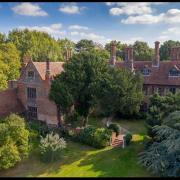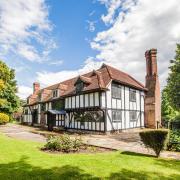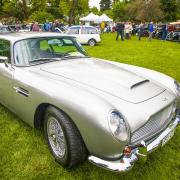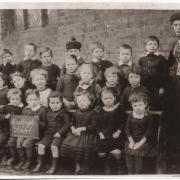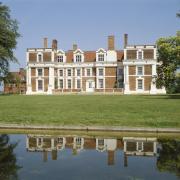Sir John de Hawkwood – the mercenary of the middle ages
Sir John de Hawkwood is believed to have been born in around 1323, second son to Gilbert Hawkwood. Although some accounts of John’s life have him rooting about in poverty when growing up – so offering a rags-to-riches story – the truth seems to have been more prosaic, his father a well-to-do tanner and landowner who held title not only in Sible Hedingham but also in Finchingfield.
As little is known about John’s upbringing, the myth-makers have moved in to fill gaps. The Italians laying claim to him must also have led to embellishment, and these two facets are distinguishable in the story that John’s mother had wanted to give birth in a wood, hence his surname of Hawkwood. This particular tall tale was concocted by an enthusiastic Florentine. Hawkwood’s association with Sible Hedingham was not that lengthy as he departed Essex for London to be apprenticed to a tailor.

It was the early 1340s when John was 20-odd that he joined the retinue of William de Bohun, Earl of Northampton, probably as a bowman, hoping no doubt to benefit from plunder during the French wars. Hawkwood may have fought at Morlaix (1342), and then reputedly distinguished himself at two standout battles of the Hundred Years’ War against the French, Crécy (1346) and Poitiers (1356).
In the latter he fought with Edward III’s son and heir, the Black Prince, subsequently being knighted by Edward, the monarch who instigated the wars aimed at plonking an English posterior on the French throne. It was the start of a military career that saw Hawkwood become a figure of myth as much as fact and one of the most famous mercenaries to depart these islands to earn coin on foreign fields.
In 1360, the Treaty of Brétigny drew a temporary truce between England and France, which left Hawkwood kicking his heels. He didn’t let the grass grow, so in the same year (some sources cite 1363) he led a merry band of mercenaries, perhaps 150 to 200, to Italy where he firstly aligned himself with the ‘Great Company’ or ‘White Company’ as it became (an English mercenary force immortalised in a novel by Sir Arthur Conan Doyle) and also with Pisa against Florence.
Hawkwood was elected captain general in 1364. He’d go on to fight for a number of different causes, his little army so sought-after he was almost continuously engaged in warfare, facing up against some Italian city state or other (there being no nation of Italy at this time). He did this for 30-odd years. Using the longbow and tactics already making their mark in the French wars, Hawkwood transported this new way of war into Italy.
He made a name for himself with rapidity for the way he deployed his infantry and the sheer discipline of those who fought under him as he instilled a camaraderie into his men. Between 1372-78, he fought alternatively for the Pope and the Duke of Milan, presumably hiring himself to whoever paid the most, and he married the latter’s illegitimate daughter in 1377. It was during these Papal-Milanese dustups that Hawkwood was captured and ransomed.

Eventually, in 1379, he cast old enmities aside and agreed to represent Florence against all comers in whatever wars she waged and commanded the Florentine armies as captain general. Hawkwood’s reward was an annual pension; nice work if you can get it. He’d also become an honorary Florentine citizen in 1391. He could still rent himself out elsewhere if the Florentines had no specific use for him at any given time, which led to perhaps his greatest ever victory in March 1387 when his Paduan army defeated the Veronese at Castagnaro.
The Italians had their own name for him. Finding John de Hawkwood an Italic tongue-twister, they dubbed him ‘Giovanni Acuto,’ which translates as ‘John Sharp’. That’s sharp as in sharp-witted or cunning, which Hawkwood was. It doesn’t fall to many English bods to have an Italianised version of their name. Mercenary he may have been, but John also had principles: he would not take up arms against other Englishmen or his King.
Hawkwood sold the various Italian estates he’d acquired as he readied for a return to England. He wasn’t to make it. When Hawkwood died in 1394, he was given a prestigious burial in Florence’s cathedral. Legend has it his body was returned to England, and he’s certainly commemorated with a monument in the south aisle of his village church, St Peter’s in Sible Hedingham, which dated from the 14th century as did the deceased mercenary.
Further along the old Roman road from the church, Sible Hedingham having been a Roman outpost, is Hawkwoods, the family home. Meanwhile, back in Florence, there’s a large fresco portrait of Hawkwood dating to 1436, more than 40 years after his death, which is in the Duomo, aka the cathedral. The work of Paolo Uccello, the enormous, prominent artwork is part of Hawkwood’s fame and mythology and shows the man mounted imposingly on his steed amidst a great procession. Given that 4.5 million visitors see it every year, that’s an awful lot of people who’ve seen his likeness and shared the myth. There are a number of engravings of Hawkwood that are ‘after Uccello’, imitation being the sincerest form of flattery.
Sometimes, unlikely little English villages prompt thoughts of far grander places and personages. Sible Hedingham is such a place, its connection to Sir John de Hawkwood causing us to ponder the famed Black Prince, the artist Paolo Uccello and the marvels of Florence. They all seem to conflate right here.

CHRONOLOGY
c.1323 – Birth of John de Hawkwood in Sible Hedingham.
1346 – The Battle of Crecy where Hawkwood possibly fought against the French.
1356 – Hawkwood fights with the Black Prince at Poitiers, another victory against the French.
1360 – The Treaty of Brétigny leaves Hawkwood seeking employment.
1363 – Possibly the year that Hawkwood took his mercenary talents to Italy.
1372 – A yo-yo period when Hawkwood fights alternatively for the Pope and Milan.
1377 – Marriage to the Duke of Milan’s illegitimate daughter.
1379 – Hawkwood becomes a leading mercenary in the employ of Florence.
1387 – Perhaps Hawkwood’s greatest victory for Padua against Verona at Castagnaro.
1394 – Death of Sir John de Hawkwood in Florence (March 17) aged around 70.








